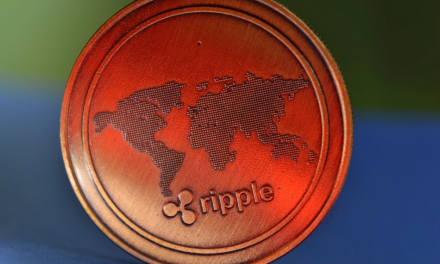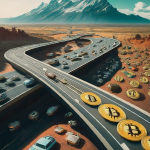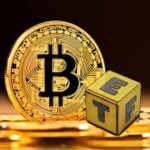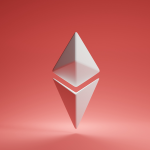- GameFi is a crucial subsector of the crypto industry and Web 3 space
- There are two unicorns in the subsector at press time
Blockchain technology is disrupting every industry, from finance to insurance. The gaming sector has been disrupted too. In most traditional games, players pay to play and can use higher scores to unlock higher levels of the games.
GameFi concepts or blockchain games replace traditional high scores or credits with cryptocurrencies and NFTs (non-fungible tokens). So for every win, you can earn cryptos or NFTs, hence the term play-to-earn (P2E).
P2E is the core foundation of “GameFi.” The term GameFi is a combination of the words “Game” and “Finance.” Gamers can now earn native cryptos and merchandise, which are exchangeable on the larger crypto ecosystem.
History of GameFi
The concept of blockchain games got traction after the term “GameFi” at the Wuhzen Blockchain Conference in 2019. However, the idea was being experimented with even before the conference.
In 2013, the gaming firm Minecraft worked on BitQuest, a server that uses Bitcoin [BTC] as an in-game currency. As such, it was one of the pioneers of GameFi projects.
After the 2019 Wuhzen Blockchain Conference, GameFi became a buzzword, and several blockchain games sprung up afterward.
A report by DappRadar showed that the blockchain games subsector thrived despite the turmoil in 2022. In Q3 2022 alone, the sector raised about $1.3B, accounting for about 50% of all blockchain activity with close to 1M Unique Active Wallets (UAW).
Some of the leading blockchain games include Axie Infinity and The Sandbox. These platforms also have native tokens or coins that are traded over major exchanges. As of January 2023, the gaming coin (GameFi) market cap was valued at $10B, according to Coingecko.
The GameFi sector is growing exponentially, with Asia, the Middle East, and North Africa showing great potential.
How Does GameFi Works?
GameFi allows you to exchange your game rewards (cryptos and NFTs) for actual legal tender. So gamers can earn, trade, or even stake and get interest on crypto and NFTs made.
However, each blockchain game has different token economics that every gamer should understand to maximize the experience and earning potential. Token economics allows the game to build an economy around its platforms.
GameFi projects can have two tokens — utility and governance tokens. Utility tokens allow you to buy in-game features like clothes and artifacts. They also distribute rewards to you and other players.
Governance tokens give you voting rights on the GameFi project. But, GameFi projects’ tokens vary in complexity and functionality. For example, Sandbox’s SAND acts as a utility and governance token.
But Axie Infinity has three tokens with different functions:
- Smooth Love Potions (SLP) as a utility token
- Axie Infinity Shards (AXS) as a voting right, so its a governance token
- RON is a transaction token on Ronin, an Axie’s sidechain.
But, the most incredible primary feature of GameFi projects is the P2E models.
The P2E model is the secret source and glue that holds together GameFi projects. Each project adopts innovative P2E to ensure a valuable gaming experience.
P2E models have two crucial parts. One is ensuring you collect in-game tokens after wins or tasks. The second part ensures you can trade the in-game tokens seamlessly on other decentralized exchanges (DEXs) platforms.
Some creative P2E models leverage DeFi and NFT concepts to drive NFT staking. Like you would earn yield interests with your stablecoins in DeFi platforms, you can do the same with your earned in-game NFTs.
Some of the games that allow you to stake your NFTs include:
- Samurai Saga
- Legends of Ancients (also allow you to earn interest by holding on to your NFTs).
- Mix Mob
- Blockchain Monsters
- Crywar
Loosely put, the P2E model allows you, as a player, to get hold of valuable in-game assets.
But you must make a substantial upfront investment to generate significant earnings. For example, you will need at least 3 Axies to play the Axie Infinity game. And each Axie costs about US$29. If you do the math, you’ll need about US$100 to start playing Axie Infinity.
With that, you can start earning Axie’s SLP tokens as you play and stake the wins.
Current State of the GameFi Market
As of March 29, 2023, there were two GameFi coins with a market cap of $1B and above according to Coinmarketcap:
- ApeCoin – $1.53B
- Decentraland [MANA] – $1.12B
Other key GameFi tokens, like Axie Infinity [AXS] and The Sandbox [SAND], had a market cap of $981M and $959M, respectively. This shows that the top four major GameFi tokens each have market caps near $1B – evidence of significant traction of P2E games and their native tokens.
Based on NFT performance, the League of Kingdoms saw incredible weekly gains of over 50%, followed by Planet IX, according to GameFi.org. It shows that League of Kingdoms saw a surge in in-game assets accruement in the form of NFT (non-fungible tokens) – digital arts that gamers win and are exchangeable for other tokens and assets.
However, GameFi projects with the largest market cap missed the top list of highest active accounts or users. Here are the top three P2E platforms with high daily active accounts:
- Planet IX [IXT] – 62K
- Nine Chronicles – 23.5K
- Benji Bananas [PRIMATE] – 19.4K
- SecondLive [LIVE] – 17.3K
- Sunflower Land [SFL] – 16.5K
On average, there are over 6 million unique active wallets (UAW) in the GameFi universe, transacting around 50 million NFT transactions, according to GameFi.org.
Some of the games driving the market include:
- Axie Infinity
- Decentraland
- Sandbox
- Alien World
- Splinterlands
- DeFi Kingdoms
- Bomb Crypto
- Sunflower Farmers
However, it is important to note that some games face serious challenges. For example, Axie Infinity was hit by a hack that stole US$625 million worth of users’ cryptos. Axie runs on Ronin and Ethereum network chains. So, due diligence is necessary before staking your in-game assets.
Other blockchain networks also power GameFi projects. Binance Smart Chain (BSC) is the leading chain supporting most GameFi projects, including Alien Worlds.
But the great potential of GameFi is attracting even traditional game giants like Netmarble. But that is just a tip of the future of GameFi.
Future of GameFi and Blockchain Games
Major platforms like Epic Games are also launching P2E games. GRIT game will feature on Epic Games as the first P2E NFT game allowing players to earn more. Apart from traditional games embracing the GameFi effect, merging with Metaverse is unavoidable.
New entrants like Oasys believe that 10 million wallets will interact with blockchain games before we jump into 2023. If you factor in Metaverse and traditional games embracing blockchain gaming, there will be exponential growth in the future.
According to Naavik, the market could reach $50 billion by 2025. That means more money will be made while playing your favorite games.
Conclusion
GameFi empowers you to earn and trade your in-game rewards. It turns your rewards into NFTs and cryptocurrencies that you can trade in decentralized exchanges like Binance.
At the core of GameFi are play-to-earn (P2E) models that make exchanging your rewards seamless. You can stake your NFTs just like you could be with stablecoins and other cryptos on DeFi platforms. You can earn by directly selling, swapping, or staking your NFTs and in-game cryptos on DEXs.
But, you must invest substantially before earning from your favorite GameFi projects.











